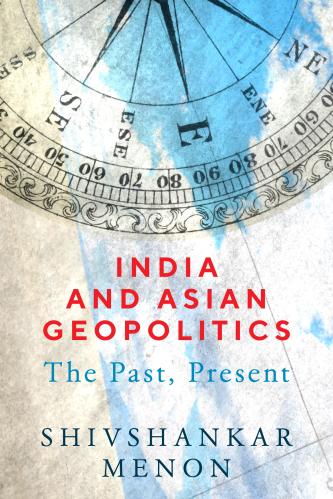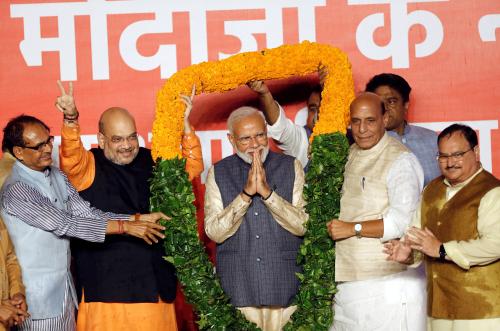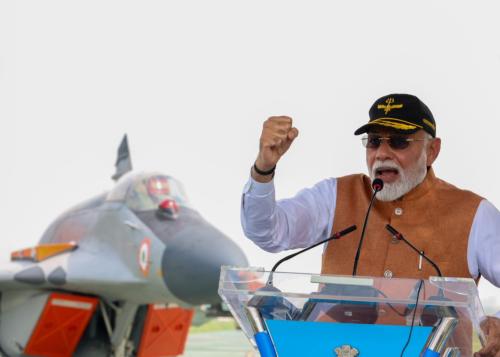From a glance at news headlines, you’d think the U.S.-India relationship is in crisis. It isn’t—not yet anyway. But it could be.
The partnership with India is one of the few U.S. relationships that has deepened notwithstanding transitions from the Bush to the Obama to the Trump administrations. But a number of differences are coming to a head over the next few months that could stall or even derail progress.
As Secretary of State Mike Pompeo plans to head to India next week, and President Donald Trump meets recently re-elected Prime Minister Narendra Modi in Japan during the G20 summit, both these convergences and divergences will be on the agenda. If not handled with care, the latter could overshadow the former, with lasting consequences.
The Positive Side of the Ledger
Over the last two years, there has been steady progress in the U.S.-India relationship. Strategically, both sides have seen the other as playing a crucial role in their Asia strategies—for the U.S., its Free and Open Indo-Pacific strategy; for India, its Act East policy. This has paved the way for deeper diplomatic, defense, and security cooperation. The two countries established a ministerial-level 2+2 defense and diplomatic dialogue last year, their highest-level institutionalized strategic dialogue. Senior bureaucrats and military officials now meet regularly, and their various security dialogues have continued to meet on issues such as defense technology, cyber security, and counterterrorism. Liaisons between the Indian navy and U.S. Naval Forces Central Command in Bahrain, and the countries’ defense innovation units, are being established.
A series of agreements—negotiated for years—that would facilitate greater interoperability and technology transfer have finally been signed. The U.S. and India have operationalized the Logistics Exchange Memorandum of Agreement (LEMOA), implemented the Helicopter Operations from Ships other Than Aircraft Carriers (HOSTAC) program, and signed the Communications Compatibility and Security Agreement (COMCASA). They are also negotiating the Industrial Security Annex that will enable greater cooperation between the defense industries, and have restarted talks on the Basic Exchange and Cooperation Agreement that could pave the way for geospatial intelligence sharing.
Their diplomatic engagements also involve other countries. The two countries have upgraded their trilateral with Japan, with the three leaders meeting last fall, and restarted and continued quadrilateral consultations that also include Australia. In 2018, after a decade, they revived their air force exercise (with Japan present as an observer), and this year, they are expected to start a tri-services exercise. In addition, earlier this year, the Indian navy joined USAFRICOM’s Cutlass Express exercise for the first time, and American observers (along with some from New Zealand) were included in the Australia-India naval exercise. Moreover, the American and Indian navies undertook a group sail with Japan and the Philippines in the South China Sea recently.
Defense trade has been another plus-point. India has started receiving Apache and Chinook helicopters (both of which beat out Russian offerings), and deploying American equipment like P-8is and C-130s to extend its reach in the Indian Ocean region. The U.S. granting India Strategic Trade Authorization Tier 1 status could further facilitate the export of advanced technology. Washington has reportedly approved the sale of armed drones and multi-role helicopters, and the two countries are also in talks for further deals.
Beyond defense and security cooperation, Washington has proved to be helpful to New Delhi in two crises—during the recent India-Pakistan tension following the February 14 terrorist attack in Kashmir, and, in a quieter way, during the Sino-Indian stand-off at the Bhutan-China-India tri-junction in 2017. In the recent flare-up, it backed India’s position, not just rhetorically, but at the United Nations Security Council. It helped draft and push through a statement condemning Pakistan-based terror group Jaish-e-Mohammed and get its leader Masood Azhar designated as a terrorist (a long-standing effort that was being blocked by China). It also took the lead at the Financial Action Task Force to grey-list Pakistan for its lack of action against terror financing. Along with Paris, Washington is now almost playing the role Moscow used to for India in these kinds of forums.
Even U.S.-India economic ties, where strains are pronounced, have deepened over the last few years. In terms of trade in goods, over 2018-19, the U.S. once again become India’s largest trading partner (if one includes services, it has held that rank for a while). Not only has U.S.-India trade grown, but, unlike with many other countries, the American trade deficit with India has decreased (from $27 billion in 2017 to $21 billion in 2018). Both American foreign direct investment into India and Indian foreign investment into the U.S. have increased. India is now also importing U.S. oil and gas (and has also benefited from the downward pressure on energy prices that American production has engendered over the last few years). The number of Indian students in the U.S. has increased, and so has two-way tourist flow.
The Negative Side of the Ledger
However, even as the relationship has progressed steadily on many fronts, a number of problems have arisen. Some stem not from bilateral issues, but from U.S. policies targeting other countries. Indian interests have been adversely affected by the American withdrawal from the Paris climate change agreement, aluminum and steel tariffs, and the change in the U.S. approach in Afghanistan that has led to talks with Taliban (which India remains highly skeptical, if not concerned about). Add to that list Washington’s sanctions on oil imports from Iran and Venezuela, both of which have been major Indian suppliers.
Then there’s the Countering America’s Adversaries Through Sanctions Act (CAATSA) passed by Congress in 2017, which was intended to target Iran and Russia. India’s decision to purchase five Russian S-400 long-range surface-to-air missile systems, however, means that it could potentially be the target of sanctions. American officials have also expressed serious concern that the S-400 purchase could limit future interoperability with the Indian military, as well as high-technology cooperation and defense sales.
Legislators have granted the president authority to waive the sanctions, but American officials have made clear that such a waiver is not a given and, among other things, requires India to show it is decreasing its dependence on Russia. And Washington is chagrined that, even beyond the S-400 deal, over the last year, India has signed additional deals with Moscow for leasing a nuclear submarine, a manufacturing facility for Kalashnikov rifles, and the production or purchase of frigates. These four deals, worth over $12 billion (with additional deals being contemplated), would count as “significant transactions” under CAATSA. They also put in perspective the oft-touted statistic that the U.S. and India have signed defense deals worth $16 billion since 2008. And they have come even as Moscow has deepened relations with Beijing, broadened them with Islamabad, and taken a neutral stance during the India-Pakistan crisis (even offering to mediate between the two countries).
The major bilateral sore spot is on the economic side, where friction over trade, investment, and immigration concerns has only increased. To pre-existing American concerns about market access and price controls on medical devices, the Trump administration has added concerns about India’s e-commerce regulations and data localization plans. The Indian government, in turn, has concerns about potential changes to U.S. immigration policies. Recently, the Trump administration ended India’s trade benefits under the Generalized System of Preferences, which affects about $5.5 billion of Indian exports. And the Modi government imposed retaliatory tariffs that it had announced last year, but suspended until this past week. Bigger shocks could be coming if the U.S. did indeed launch a broad-spectrum investigation into India’s trade and investment practices, as is reportedly being considered (or at least floated as a negotiating tactic).
These trade frictions are of particular concern. For one, it is an issue President Trump cares about deeply, and the grounds on which he measures relationships—far more than what any country does or does not do on the defense and security front. Second, he has shown that he is willing to link national security and trade commitments even with allies—this is a far cry from the last two administrations, which prioritized long-term strategic ties over short-term economic frictions. Third, the basket of issues on which there are differences has expanded. Fourth, given that these economic difficulties involve and affect key domestic priorities and constituencies for both governments, concessions are not easy for either side to make. And finally, both sides seem to believe they are speaking from positions of strength and might feel they do not need to make concessions—Modi after receiving an even stronger electoral mandate, and Trump after garnering concessions from countries like Canada and Mexico.
Add to this another potential issue coming down the pike: the security of India’s future telecommunications system. And then there’s the possibility of a U.S.-Iran escalation, which could throw a spanner in the works. It would not just complicate India’s relations with both countries (not to mention Israel, Saudi Arabia, and the United Arab Emirates), but also be seen as seriously disruptive to Indian interests in the Middle East, which houses millions of Indians and is a key source of the oil and natural gas India consumes. Any escalation would also hinder India’s attempt to establish a (non-Pakistan) transit corridor through Iran to Afghanistan. Moreover, it would (once again) distract the U.S. from focusing on Asia, where Delhi sees more converging interests with Washington.
Divergences vs. Convergences
This series of differences—coming as they do together—threatens to overshadow the very real progress in U.S.-India relations in the first couple of years of the Trump administration. They have already reinforced traditional concerns that the two countries have about each other. In the U.S., in some quarters, this includes asking whether the relationship with India is worth it; in India, whether the U.S. is reliable.
Advocates of the relationship and of the Free and Open Indo-Pacific concept should not be sanguine that structural and strategic factors—particularly convergence resulting from concern about a rising China’s behavior—will naturally keep the divergences from dominating over the convergences. They will have to work hard to ensure that they will not do so.
This will mean the two countries needing to get off their respective high horses and show a willingness to make concessions, find compromises, and strike deals across sectors.
Highly unhelpful, if not, counterproductive is the fact that both sides have forgotten a lesson learned over the last decade and a half—that differences between the two countries are better managed or resolved if they are sorted out behind closed doors. Washington has been particularly guilty of forgetting this over the last few months. Publicly demanding that countries make a certain choice makes it harder for them to make it. In India’s case this means that even though the U.S. has now reportedly offered India options if it doesn’t go through with the S-400 acquisition, the way this has played out publicly makes it harder for Delhi to walk away from this deal, as it has done with others.
The public statements on S-400 or leaks from sources threatening retaliatory caps on H1-B visas (which is a congressional prerogative) reinforce the image that many still hold in India of an America that makes demands of India in terms of policies or purchases, constrains its choices, and does not take its interests into account. It strengthens the hands—and arguments—of those in the establishment who remain skeptical, if not suspicious, of an Indian partnership with the U.S. This sentiment is not just prevalent on India’s left, as a recent speech by the head of the Rashtriya Swayamsevak Sangh made clear. Finally, public pressure muddies independent cost-benefit debates that Indians should be having about the S-400 or telecom policy that have now been framed as making a choice between the U.S. and Russia or the U.S. and China.
India, for its part, cannot complain about American transactionalism, even as Delhi makes plenty of asks too. Moreover, it needs to acknowledge that agreements like LEMOA are not India doing the U.S. a favor—they are in Indian interests, helping it enhance military capability and reach. And, particularly given the slowdown in economic growth, Delhi needs to ask itself whether its current approach to trade and foreign investment is the right one, or whether it can do more to benefit from global engagement (as it has done in the past), and particularly the U.S.-China trade war.
Indian observers need to resist framing everything as a choice imposed by the U.S.
Meanwhile, Indian observers need to resist framing everything as a choice imposed by the U.S. Furthermore, critics cannot first complain about the U.S. not offering India high-end defense equipment and then, when it does offer equipment (often on the Indian government’s request), complain the U.S. is demanding that India buy it. This line has become so engrained that critics dismiss or ignore India’s own concerns about Russian defense companies or Chinese telecommunications companies. They allege, instead, that the U.S. is forcing a choice to benefit its companies, sometimes forgetting that, in many cases, it is European and not American companies that offer the alternatives.
Overall, if the strategic relationship—and the U.S. and India’s Asia strategies—is to endure, the two countries will have to remember that the relationship has been strategically and economically mutually beneficial. They will have to step back from the brinkmanship visible in recent weeks. To some extent, both sides are perhaps behaving this way because there’s a sense that convergence on China—and mutual need for the other in their respective balancing strategies—will make the other side blink.
But history tells us that is not a given. In the years after the 1962 war, there was a similar shared American and Indian view of a China challenge. But their cooperation to tackle that challenge first slowed and then stalled because of American asks (India-Pakistan talks, limiting defense deals with the Soviet Union, economic reform), and India’s inability to deliver on its economic potential. What that led to is limited U.S.-India relations, greater space for China, and increased India dependence—and then overdependence—on the Soviet Union. We should not assume that a similar scenario is impossible today.
The Brookings Institution is committed to quality, independence, and impact.
We are supported by a diverse array of funders. In line with our values and policies, each Brookings publication represents the sole views of its author(s).







Commentary
As Pompeo heads to Delhi, the US-India relationship is at a critical juncture
June 21, 2019